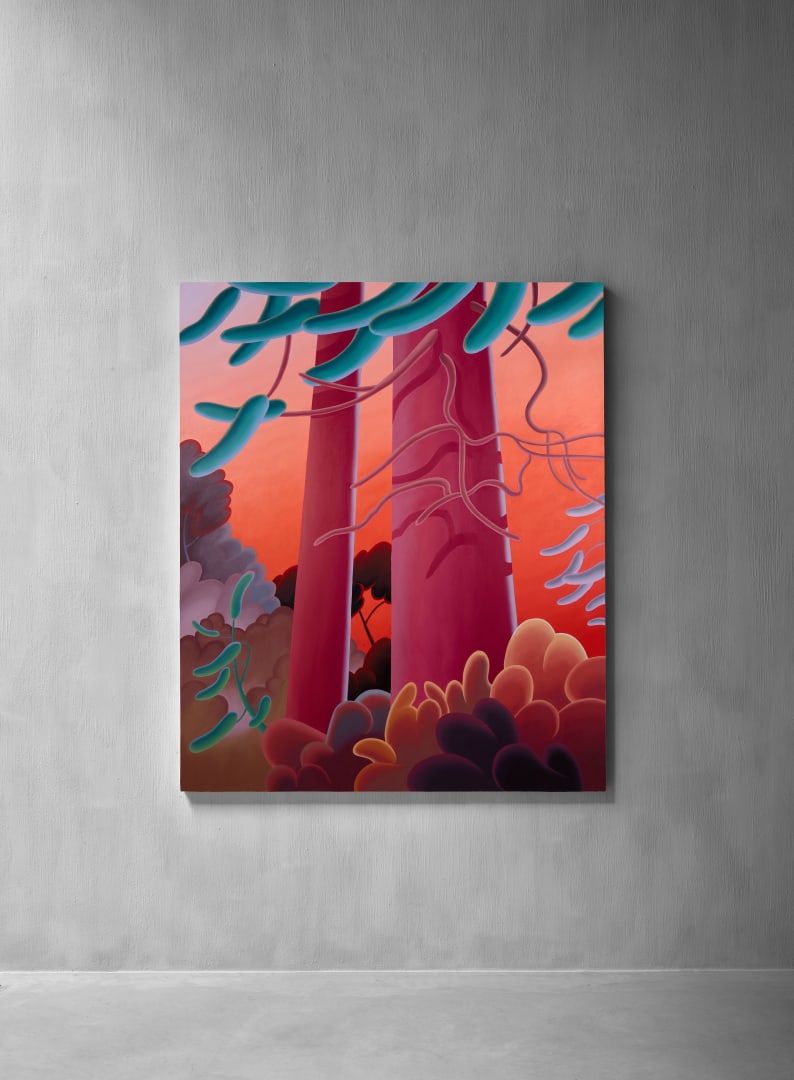Narratives departing from the American dream are numerous and often disheartening. In Death Motel, the first solo exhibition of Madeleine Bialke at Newchild, one of those narratives, namely, the experience of a lifestyle close to nature is undoubtedly on the brink of crumbling. The 1920s saw the birth of a new trend coined among the urbanites as ‘relaxation in nature’. The Vanderbilts, Rockefellers, Morgans and others of the newly rich, the very same industrialists whose railways, mines and financial activities had jeopardised the wilderness, now embraced a new spirit of conservation, overlaid with nostalgia for a simpler life closer to nature. This emergence of back-to-nature became an idealized mantra of looking the other way as 'America's evolution from a nation of Main Streets and coherent communities to a land where every place is like no place in particular, where the cities are dead zones and the countryside is a wasteland of cartoon architecture and parking lots', as writer James H. Kunstler explains in his book The Geography of Nowhere.
The Adirondack Mountains became the grounds in which these 'newly preservationist' constructed family camps — compounds consisting of multiple buildings that recalled European villages; indigenous materials—stone, wood and bark—were adapted to Old-World-style rustic architecture. Bialke would spend many summers in the Adirondacks from an early age. This is also where the Gillette-Brown murder took place at the turn of the 20th century. A shocking and scandalous murder, whose details swept the nation, of an American woman drowned by her boyfriend after she told him she was pregnant. This gruesome story became a sensation with the help of author Theodore Dreiser in his novel Murder in the Adirondacks: An American Tragedy. His story underscored individualistic selfishness as the driving force of the American dream and traced how the pressures of society toward financial success and the protagonist's irresistible urges drove him to his own destruction.
For Bialke the Murder in the Adirondacks story catalyzes her interest in nature and society. This glorification of extreme individualism and materialism introduced by the American dream is questioned in her hypnotic paintings. In Wingspan, a minuscule American flag hangs lonesome on a vast horizon where large, dark-mauve, billowy clouds loom unreflected in the lake of what is seemingly the Stillwater Reservoir—a man-made dam that destroyed access to and incidentally protected the last virgin forest in Northeastern US.
The works in the exhibition display a skilful use of colour that generates and indicates emotion. At times atypical hues appear undisturbed like polluted gradients, referencing the balance and imbalance between colour and nature in an expressionistic manner. Bialke’s distinctive compositions built of layers upon layers, remind us that the natural world is not exclusively a resource for humans but a living organism, as is in the case of The Land of Giants. The large canvas depicts a view from the overstory of the forest, where two enormous trees loom above it, tall and eerie. Here people and trees uncannily mirror one another in what could be described as a mutual understanding. It's as though the trees and foliage themselves are suffering from the same ailments, aware of what is happening to the world. Yet their strong presence reminds us of the grandiosity of nature and its sweeping generosity to all living beings, as the forest is an ecosystem where all plants aid each other through a complex network of roots and fungi.
The notion of Death Motel has been with Madeleine Bialke since 2019, and the exhibition is the culmination of her explorations in an ecosystem specific to the Adirondacks. This concept developed as a curatorial project examining the rupture of American idealism and the natural and rural homogeneity of America. For Bialke, it was after the pandemic that a sense of urgency, heightened by abrupt life changes in combination with a diagnosis of Lyme disease around the same time, made the creation of this body of work essential. She was naturally affected by feelings of mortality and, by extension, by the tenuous nature of the world and society displayed at that time.
Many of the works in Death Motel describe the silent journeys around the reservoir of the Adirondacks, penetrating our psyche with wide values, abutting hues, and gradients deceivingly natural that confront the viewer with a place where realism is unsettlingly familiar. Her depictions of the sky – although in natural transitions – are very uncharacteristic in colour: poisonous warm oranges, pinks that gradate to greens, that merge into lavender, and mauves. Bialke’s change of colours might actually reflect a changing environment, as she explains how 'our atmosphere has been changed by us for the last 200 years, but more drastically so over the past 50 years'.
Bialke’s realism is of a philosophical kind denoting environmental frustration. The ideas surrounding her work accentuate the reality that people from individualistic cultures perceive climate change as an intractable problem, and cannot be helped by the efforts of an individual. This thought correlates with ideas of climate change helplessness: the belief that climate change is beyond personal control, which emphasises individual experience over collective action. Therefore, climate change helplessness prevents action because it seems unattainable. In Death Motel the artist invites us to view her undulating landscapes as an experience from inside the forest, from the point of view of a tree, or of any being nourished directly by nature. In essence, encouraging us to embrace our interconnectedness and the need of mankind to function collectively, like the trees in the forests she admires and honours.
You can buy a lobster in the middle of a park in Brooklyn, [and I just wonder] how much ice did we use to just get this lobster into the middle of that park in Brooklyn, where you can’t even really have trucks.

